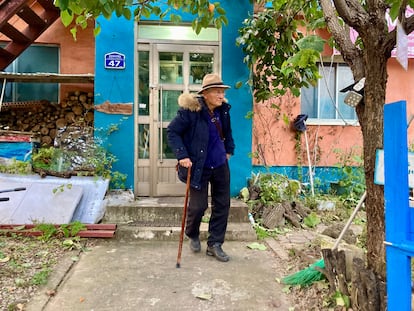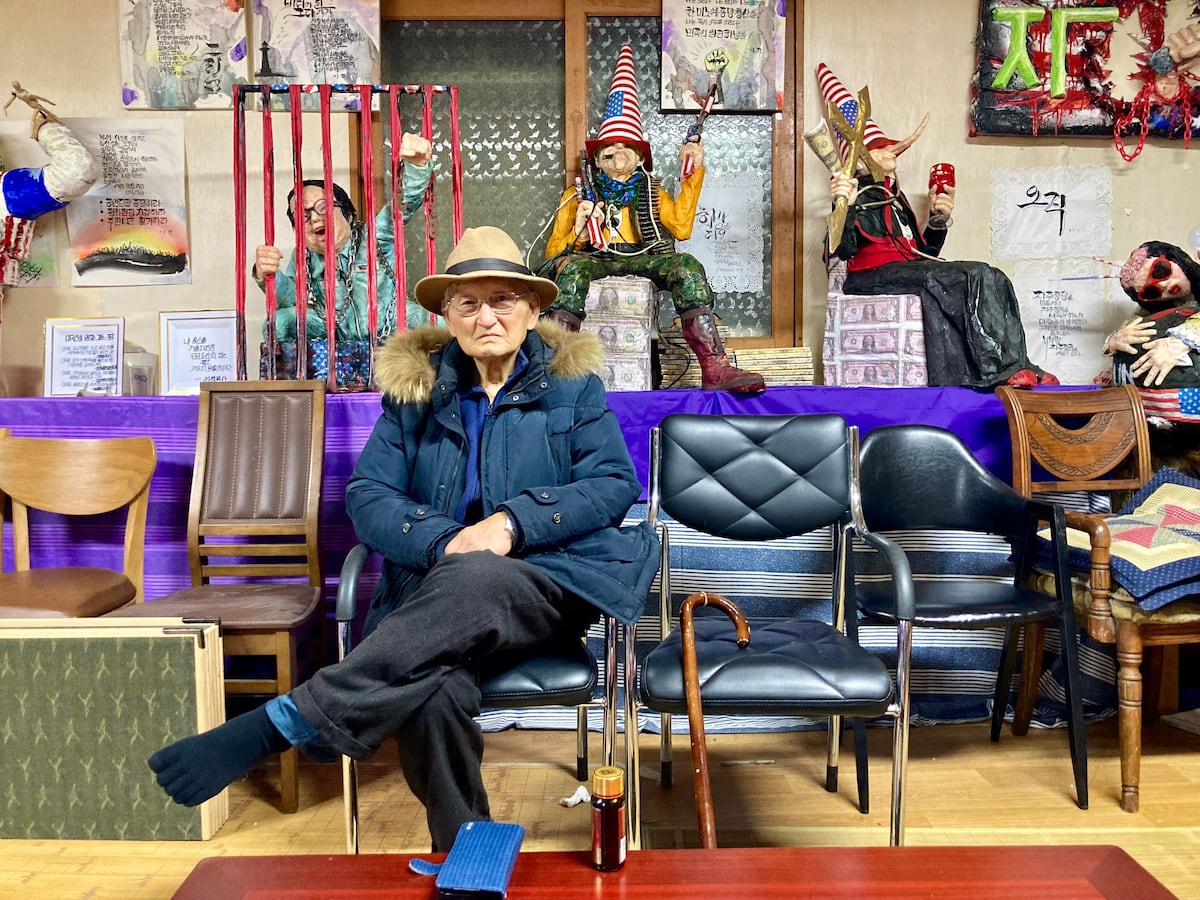— Why do you want to return to North Korea?
— It’s a long story. I have to tell you what has happened over the last 70 years…
Ahn Hak-seop is a relic of the Cold War. To visit him, you must also go to a place where the Cold War is still alive.
The fence crowns a landscape of farmland. “That over there is North Korea,” says Pastor Lee Jeok, who is driving the car. Beyond the barbed-wire fence, anti-tank defenses are visible on the South Korean side of the Demilitarized Zone (DMZ), the border strip between the two Koreas; then, the leaden waters of the Han River unfold. On the opposite bank, the bluish hills of the world’s most isolated country come into view. Technically, both sides are still at war.
Pastor Lee is the contact to reach Ahn. He has just passed through a military checkpoint to access this area under the control of the South Korean army, due to its proximity to the North. Here, in this small village in Gimpo, about 25 miles northeast of Seoul, is Pastor Lee’s parish, the Mintongseong Peace Church. He professes the Christian faith, but when asked about it, he says the church is dedicated to the reunification of Korea and to carrying out anti-American activities.
Regarding U.S. President Donald Trump, who landed in South Korea the same day in late October that EL PAÍS visited Lee, the pastor says: “It’s as if he’s come to inspect a vassal state.” His is an unusual parish. After driving up a tree-lined road, he stops the car in front of a house with an overgrown garden, where weeds climb everywhere, and a banner hangs by the entrance: “Return Ahn Hak-seop, the world’s longest-serving prisoner of war, to the North immediately, 42 years.”
Upon crossing the threshold, a U.S. flag doormat awaits, positioned so that it’s the first thing one steps on. Inside, Ahn Hak-seop, a 95-year-old former communist soldier in the North Korean army, listens to a Soviet military march on his cell phone. A friend of the pastor for many years, he now lives at the parish, near the border.
Ahn rests his hands on a walking stick and wears a felt hat. He was taken prisoner by the South in 1953. Convicted of espionage, he suffered brutal torture, but never signed a confession. He spent 42 years in prison and was one of the few who never changed his ideology. His unwavering gaze reflects his unyielding beliefs: “People don’t realize that we are like slaves under American colonial rule,” he says about South Korea.
The South Korean press calls him a “long-term prisoner who has not converted.” He is “one of six elderly former North Korean soldiers and spies who have not yet renounced their communist beliefs linked to North Korea, despite having spent decades in prison in the South.”
Now that his life is drawing to a close, he wants to return. A group of activists supports his cause. They have organized press conferences and demonstrations to demand that the Seoul government allow him to go back. Last summer, he tried to cross on foot, with the slow gait of an old man, through Panmunjom, the border village where Trump and North Korean leader Kim Jong-un greeted each other in 2019. Ahn was detained by the military before he could leave South Korean soil. It’s difficult to understand his reasons for wanting to return to a place so many want to escape.
— I have to tell you what has happened over the last 70 years…
Ahn was born in 1930, when Korea was under Japanese rule, on Ganghwa, a border island a few miles from the parish where he now resides, in what is now South Korea. At that time, there was no such division, and he identifies as North Korean. He was not yet 10 years old when the world was engulfed by World War II; 15 when the war ended and the great powers that had contributed to Korea’s liberation — the United States and the Soviet Union — were debating the peninsula’s fate.
He says his anti-American sentiment began to take shape when U.S. General Douglas MacArthur announced the establishment of a military government south of the 38th parallel, the line that still separates the two countries today. “My political awareness began to develop.” Korea, he says, went from one colonial government to another.
 Ahn Hak-seop at the door of the parish church.Guillermo Abril
Ahn Hak-seop at the door of the parish church.Guillermo Abril
Before the Korean War broke out, he studied in Kaesong, then under South Korean control, and now part of the North. There, he joined the Communist Youth League and participated in underground activities to subvert the American presence. He had run-ins with the police, spent time in hiding, and lived “under bushes and pine trees.”
The outbreak of the war in 1950 caught him at the age of 20. China came to the aid of the North with millions of fighters, and the USSR provided weapons. The South, with U.S. support, contained the blitzkrieg. From the first year, he remembers the Battle of Chosin. “There were many wounded Chinese volunteers; I helped with the transfers [to hospitals]. At the end of 1950, I went to Seoul…” He closes his eyes. He asks for a moment to think. He searches his memory, which seems shrouded in mist.
Sometimes it’s hard to follow him. The interview is conducted through an interpreter. Pastor Lee approaches and places some ginseng drinks on the table, with a metallic, sweetish taste. Ahn drains the small bottle almost in one gulp.
In 1951, he formally joined the North Korean ranks as “second-in-command of platoon 941, directly subordinate to army unit 52,” he rattles off. It was a six-man group assigned to move through the South, behind enemy lines, to support North Korean detachments. Their role was to deliver supplies from the North. In April 1953, three months before the armistice, when his unit had been completely decimated and he was the sole survivor, South Korean troops captured him. “I was in uniform,” he says. It’s a relevant detail: despite this, he was accused of espionage, and a cycle of brutal interrogations and torture began, lasting for decades. He was subjected to the ideological conversion programs, through which prisoners were forced to renounce communist ideology.
“I fully met the criteria to be considered a prisoner of war under the Geneva Convention. As such, I should have been returned,” he protests. “It was a violation of international law and a crime committed by South Korea.” When asked about the torture, he lowers his chin to his hands resting on his cane, and his voice breaks: “When I talk about it, my heart pounds, and I can’t sleep.”
He speaks of an icy cell he could barely fit into sitting down; of his arms being dislocated until they cracked; of whippings with knotted ropes; of simulated drownings; of his bare feet being beaten with sticks until his toenails fell off. He takes off his hat and points to the spot on the top of his head where they poured ice-cold water on him constantly until it felt as if he were being hit with a rock: “It drove me to the brink of madness.” They encouraged him to sign a confession, saying he could resume a normal life. He never agreed. The mistreatment lasted for years.
South Korea changed in the late 1980s. Democracy arrived. Ahn Hak-seop was finally released in 1995, thanks to pressure from human rights groups. In 2004, a government panel reported 77 inmate deaths linked to the ideological conversion program using torture. Later, another panel recognized Ahn as a victim of torture, according to a report in The New York Times.
He was released at 65; the Iron Curtain had fallen, and capitalism had transformed the country. At 70, he married a woman 32 years his junior. Today, she suffers from dementia and lives with a relative. He could have returned to North Korea in 2000, when Seoul organized the voluntary return of dozens of former prisoners. He chose to stay because he felt he had to defend his ideals in the South.
He met Pastor Lee, an activist who had been in a re-education camp in the 1980s after being accused of violating martial law during the regime of South Korean dictator Chun Doo-hwan. Ahn would eventually legally adopt the pastor’s wife as his daughter.
 Some of the anti-American works created by Ahn Hak-seop’s adopted daughter.Guillermo Abril
Some of the anti-American works created by Ahn Hak-seop’s adopted daughter.Guillermo Abril
Ahn’s adopted daughter, who recently passed away, is the creator of the anti-American papier-mâché sculptures that fill the room. One depicts the Statue of Liberty, armed with a rifle, smoking a cigar, and with dollar bills peeking out of her clothing.
“North Korea is the birthplace of my ideology,” Ahn reflects. “I like socialism. The root of all problems is private ownership of the means of production. It only breeds greed. Here, the children of the rich live in luxury while others have nothing.”
When asked if he is aware that Pyongyang is accused of committing very serious human rights violations against its population, he replies: “People say North Korea is a dictatorship. But I feel that’s all lies. What is a democracy?” He defends Kim Jong-un: “He’s doing a good job.”
Six non-converts like him have requested permission to return to North Korea in recent months. His case is under review by the South Korean Ministry of Unification. Meanwhile, the North has not issued any statement, according to the Yonhap news agency.
“Those I knew in North Korea must be dead by now. But that’s irrelevant,” Ahn confesses. “I’m almost 100 years old. I’ve lived a long time. I’ve lost all affection for this country. I was born under colonial rule. I’ve suffered all kinds of human rights abuses, and even in death, I thought, I’ll be buried in colonial soil, while my colleagues rest in the independent land of the North. My legs can barely support me anymore. I’ve lost consciousness several times. That’s why I want to go back before I die. I must die in the North.”
He acknowledges that there are things he likes about the south; the welfare state, for example, “inspired by communism.”
— And have you ever tried an American hamburger?
It’s the only time he laughs during the interview.
— I did. And it was good. Much better than eating rice all the time.
Sign up for our weekly newsletter to get more English-language news coverage from EL PAÍS USA Edition
